Showcasing plants that thrive in difficult locations
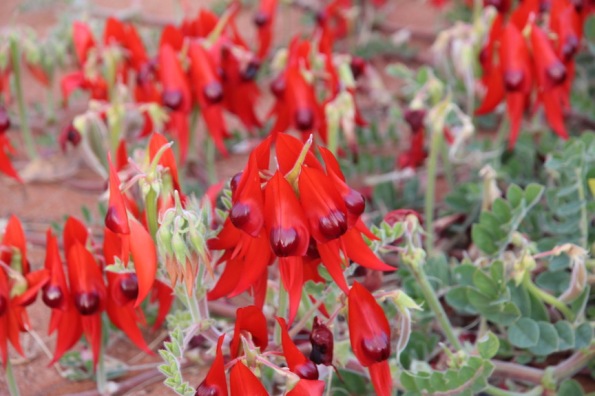
Sturt’s Desert Pea
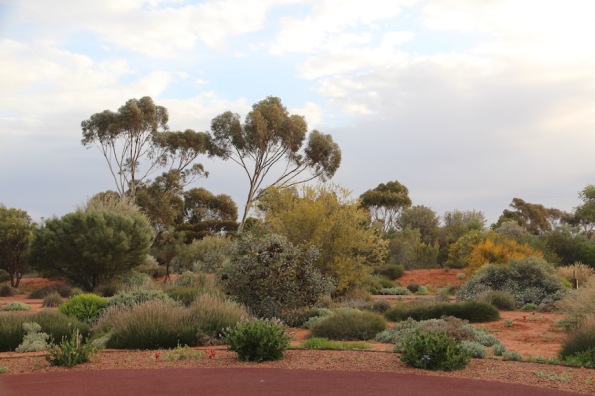
Landscape at the Australian Arid Lands Botanic Garden
Our recent road trip to and around South Australia included a mixed bag of sights. The primary attraction was a week-long tour to Lake Eyre and environs (coming soon), but there was a lot more to enjoy such as the Marree Man and Mutonia Sculpture ParkMutonia Sculpture Park.
Another unexpected treat was a visit to the remarkable Australian Arid Lands Botanic Garden. Located in Port Augusta (about a four-hour drive north of Adelaide), the garden is proof that the desert can grow and create beauty.
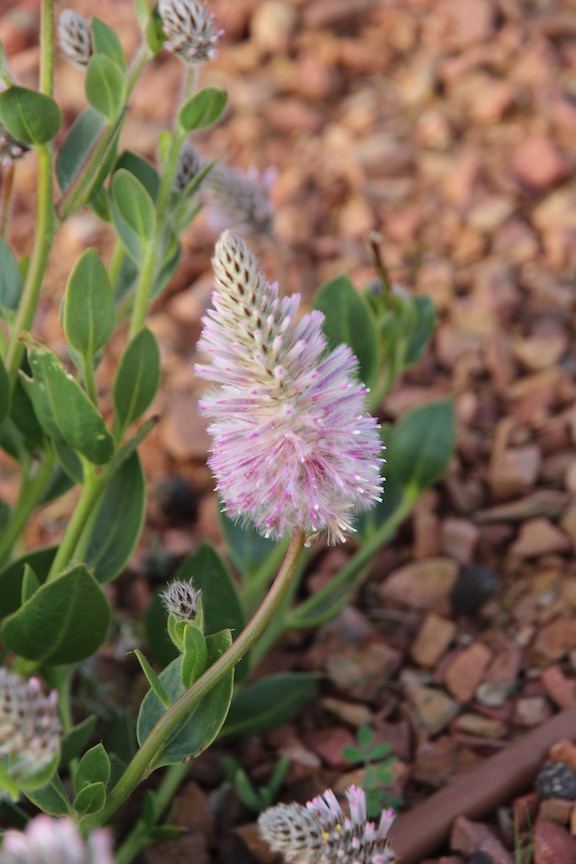
Ptilotus exaltatus, pink mulla mulla
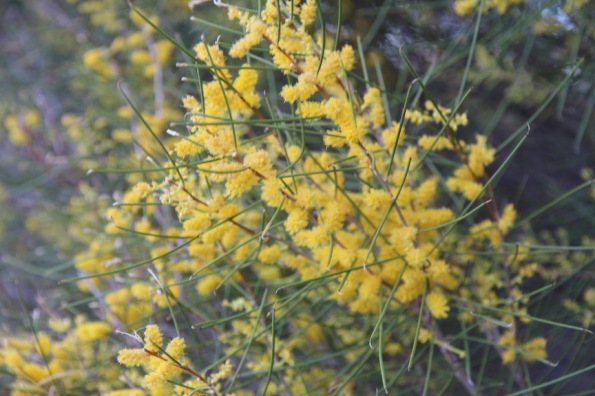
Acacia papyrocarpa, Western Myall,
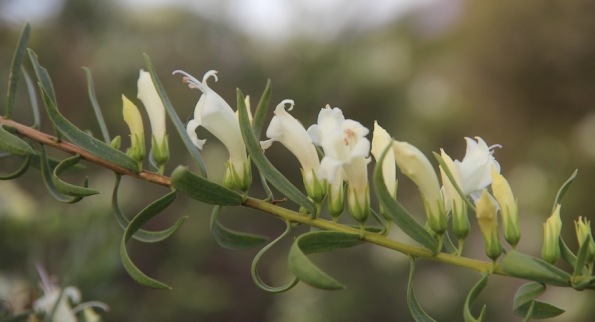
Eremophila, Native Fuchsia
It’s worth noting that Australia’s arid zone ecosystems are fragile, complex and occur nowhere else on earth. This garden receives an average of 300mm (12 inches) or less of rain each year. Developers put a lot of thought into choosing plants—from Australia and overseas—that would thrive and survive under these circumstances.
One of the garden’s aims is to promote flora that suits the region. To help people choose plants that are waterwise and more suitable for the climate, the garden features six AridSmart Display Gardens. These are the Desert Garden, the Mallee Garden, the Arid Courtyard Garden, the Eremophila Courtyard Garden, the Flinders Ranges Garden, and the Coastal Garden.
Once established, the plants in the Desert and Coastal Gardens require no additional watering. Plants in the other four gardens require between 7,000 and 23,000 litres of water per year, compared to a traditional home garden with lawn that needs about 100,000 litres of water per year. See my note at the bottom about the catastrophe of Australia’s main water system.
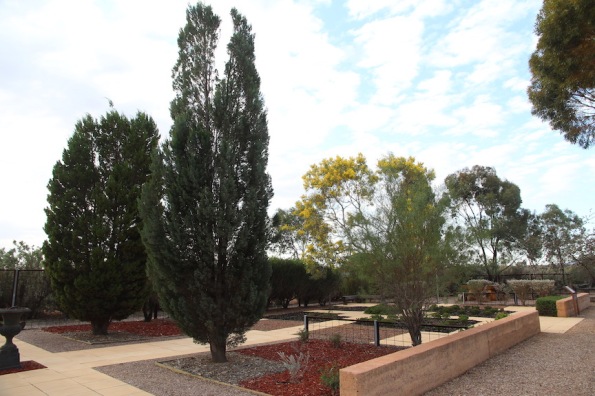
One of the AridSmart Display Gardens
AridSmart plants can be purchased in the garden’s gift shop and are:
• exclusive to the Australian Arid Lands Botanic Garden
• sourced from the country’s most remote arid regions
• selected for beauty, vigour, toughness and reliability
• tolerant of a range of soil types and climatic conditions
• hardened for 2 to 8 months in temperatures up to 47°C (116.5°F)
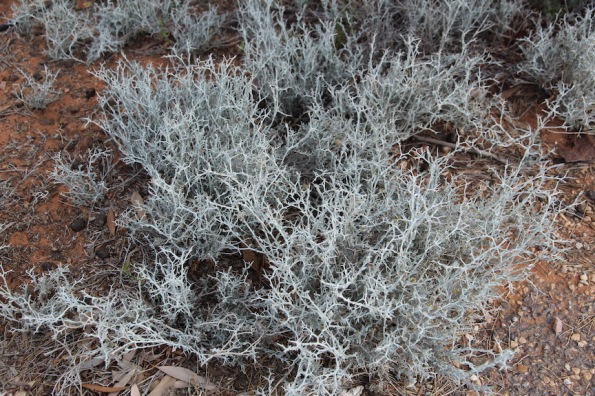
The rare spiny daisy
The garden also has a rare plant collection. I was surprised to learn that Australia has almost 25% of the world’s rare and threatened plant species. One of the rare plants is the spiny daisy (Acanthocladium dockeri). Samples were first collected in 1860 by the Burke and Wills expedition. It was thought extinct until four sites were discovered in mid-north South Australia in 1999–2000.

Rhodanthe chlorocephala ssp. rosea
Two of my favourites
Sturt’s Desert Pea (Swainsona formosa) is my favourite plant in this garden. It’s pictured at the top and bottom of this post. I love its blood-red and drooping flowers. It is South Australia’s official floral emblem and is named after Charles Sturt, an explorer who led three important expeditions into Australia’s arid interior in the 1800s.
Samphire (Halosarcia spp.) is another favourite. I first learned about this chenopod about 10 years ago. Samphire and its relatives are a versatile source of food and medicine. It grows in sand and saline conditions, and is extremely drought tolerant. We should be making more use of it.
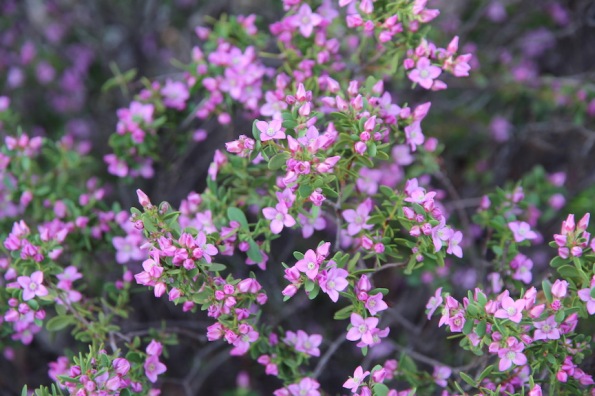
Boronia crenulata, Aniseed boronia
A bit of background
The garden was designed by landscape architect, Grant Henderson. It was established in 1993 and officially opened in 1996, but the idea for it dates back to 1981. That’s when local parks and gardens superintendent, John Zwar, proposed a garden to promote and conserve plants that could thrive in the city’s arid conditions. City Council accepted the proposal and set aside the current 250-hectare coastal site.
In 1984, an active ‘friends’ group was formed to promote the garden, seek funds and lobby for its development. In 1988, a management advisory committee was formed. Things really began to take shape in the 1990s with a master plan, major infrastructure development and plantings.
More about Australia’s main water system
Friend and fellow blogger, Tony, has researched and written a comprehensive post on the catastrophe that is taking place in our vital water system—the Murray–Darling Basin. I highly recommend this post. You can find it here.
Another article says that Australia may have lost up to 90% of its waterbirds.
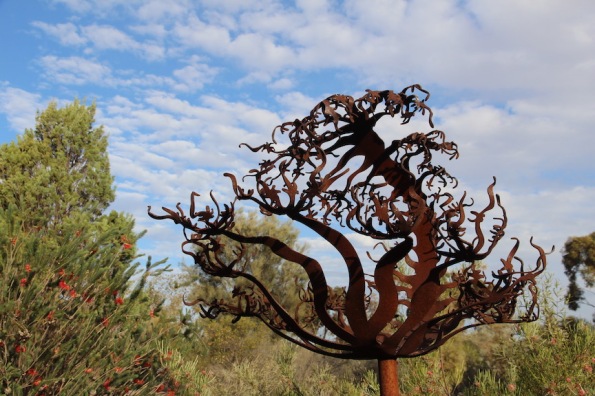
Sundew, sculpture by Warren Pickering
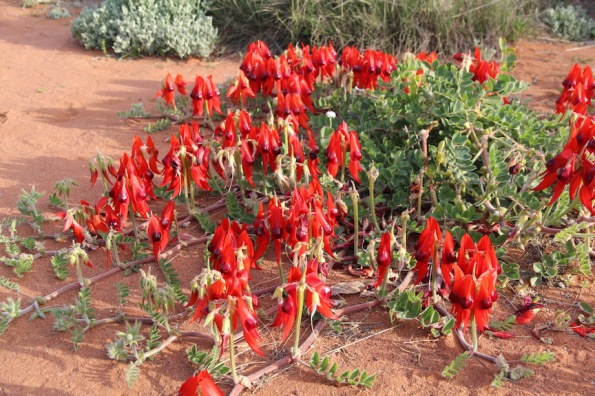
Groundcover of Sturt’s Desert Pea



Reblogged this on Blue Dragon Journal and commented:
This is a wonderful sharing. Yes, it is vital for people to become aware of what plants (flora) thrive in a particular climate zone and even micro-climate. Traditional Western gardens with huge lawns and thristy shrubs are not suitable for desert or mountain climes. Lovely photos!
LikeLiked by 2 people
Thanks so much. About 20 years ago, we replaced all of our lawn with hardier plants. We are thrilled that we don’t have to mow.
LikeLiked by 1 person
Great planning. When you work with your environment, it works with you.
LikeLiked by 1 person
Some lovely plants and flowers, I suspect in the coming years we will all need Aridsmart plants!
LikeLiked by 1 person
About 20 years ago, we switched over to more AridSmart plants. That said, I still grow a few fruit trees, herbs and tomatoes.
LikeLiked by 1 person
A very interesting post, Peggy. I read the linked post about the water basin – what a mess! We have done so much damage (and continue to damage at an extraordinary rate).
LikeLiked by 1 person
I’m so glad you followed the link. Such a valuable post.
LikeLiked by 1 person
A fascinating enterprise. I agree the desert pea is quite a stunner.
LikeLiked by 1 person
I think it’s one of Australia’s prettiest.
LikeLiked by 1 person
Some stunners there, Peggy. I suppose our Beetley weather couldn’t be more different, as it is so rarely dry. I could probably grow water lilies on our lawn. 🙂
Best wishes, Pete.
LikeLiked by 1 person
The UK has had so much rain this last month. Wish we could transport some of it.
LikeLiked by 1 person
Amazing!
LikeLiked by 1 person
Yes, it is.
LikeLike
Such an educational and informative post, and lovely photos with the scientific names. You put so much effort into each post. Wow. I live in a dry climate and your post made me think about how much water goes into lawns. The times are a-changing though, more and more lawns, especially front lawns are converted every year by owners into low water usage, with rocks and desert plants. We do get rain here but water conservation is becoming a higher priority.
I think Arizona has developed also some grass seeds that result in a lawn that after two years has much deeper roots than average and therefore no watering.
In Canada we are blessed with lakes, and rivers and have been wasteful in the past, and still are, but we are improving.
LikeLiked by 1 person
Thanks. I’m often surprised by how long some posts take to come together.
Water conservation is top of the list for us. We removed all our lawn about 20 years ago. I water the herbs and tomatoes with a bucket. The fruit trees get what falls from the sky.
LikeLiked by 1 person
I have heard disconcerting news lately from Australia, I do pray the fires are under control, and the nature will recover soon!
Christie
LikeLiked by 1 person
The existing fires will burn for weeks to come. There are great concerns for Thursday when temperatures sky rocket and the winds pick up. No rain predicted. 😦
LikeLiked by 1 person
Oh noo, I’m sorry to hear that. Hope a miracle will happen and they will stop soon.
Best wishes!
Christie
LikeLiked by 1 person
Thanks. Our firefighters are doing everything they can to prepare.
LikeLike
Fun reading for someone who is still learning about all the native plants that can grow here in Texas. On the hot side, new-to-me cacti do well here. On the humid side, so do a number of tropical plants I also never encountered in my last home of Chicago! I’m all about water-appropriate plants and enjoyed reading about your difficult environments in Australia.
LikeLiked by 1 person
Nice to know that some of Texas can support tropical plants. That never occurred to me.
LikeLiked by 1 person
The Western Myall sounds a lot less sociable than the Southern Youall, don’t Y’all think so?
LikeLiked by 1 person
I agree completely. 🙂
LikeLike
Like
LikeLiked by 1 person
All of these are lovely, but I’m also fond of the “Sundew” sculpture…
LikeLiked by 1 person
I like it too.
LikeLike
Sturt Desert Pea never ceases to amaze me. There’s usually quite a lot flowering in the north when we’re up there and their colour is so vivid even against the red dirt that they almost look to be painted. We have the Spiny Daisy growing near us. I volunteer to do the flowers at a local facility and often put sprigs of the silver from the Spiny Daisy in with roses, which looks quite pretty together. I never knew what it was called.
LikeLiked by 1 person
Oh Chris, I’m delighted to have identified a plant for you. And to think that it’s rare!
LikeLiked by 1 person
Good post, Peggy. As you know, we wander in desert country a fair amount. We have also been suffering and on-again/off-again drought these past few years. That was the reason we had to have 40 trees cut down on our property. A plant we have found that is excellent (we grow a lot of it) is lavender. It is drought resistant, fire resistant and deer resistant! Perfect for our house. Plus is attracts hundreds of bees and butterflies. I’ve been reading about your fires. Scary. Ours are bad enough. –Curt
LikeLiked by 1 person
Lavender is a great option in Australia. Most of the natives we’ve planted in our garden were chosen because they attract bees, birds and butterflies. Hope your fires are under control soon.
LikeLike
Another great post and these photos are gorgeous!! 💕
LikeLiked by 1 person
Thanks so much. So glad we could visit. I hadn’t known about the gardens until we got there.
LikeLiked by 1 person
Great article Peggy and as usual beautiful photographs! As with Maree Man and Mutonia Sculpture Park, I’d never heard of the Australian Arid Lands Botanic Garden. Wow, new places to see! Especially in the arid zone.
Thank you also for linking to my Murray-Darling Basin Catastrophe. It is something that all Australians need to know, especially those of us who live in and exist on the Murray-Darling Basin. We’ve all been inattentive and we need to get angry.
All the best.
LikeLiked by 1 person
Delighted to add the link. I want to link to your piece every time I write a post that features water. You’re right, we need to get angry about the treatment of our Murray–Darling Basin.
LikeLike
The state of our rivers are a catastrophe, the weather forecasts predict climate change catastrophes, fires everywhere, our aged care is catastrophic with over 8000 assault cases reported to The Royal Commissioner. We will be lucky to get out of it.
Thank goodness for your lovely photographs, Peggy, and well researched article. I loved it.
LikeLiked by 1 person
Thanks Gerard. Our future looks quite grim.
LikeLike
Very interesting post, Peggy. Thank you. With climate change, the extremes will become the new normal.
LikeLiked by 1 person
Certainly not looking forward to this new normal.
LikeLike
I’ve only just become acquainted with the Samphires and there are actually quite a lot in my area due to the large volume of water, almost lake-like that runs parallel to my river.
I wouldn’t be in the least surprised that we’ve lost so many waterbird species. I’ve been looking through my Sunday walk images trying to find something interesting to talk about and/or upload and my first reaction is…..how incredibly dry the fields are for this time of year. I hardly saw any birds compared to 3 years ago when I moved to the area.
LikeLiked by 1 person
Samphire is definitely under-appreciated. Maybe it will become popular like kale. The loss of waterbirds is very disturbing. You are such a keen observer so would be very aware of changes in the landscape and wildlife.
LikeLiked by 1 person
What a fabulous place. Sturt’s is a fave of mine too. At least this place exists so people can get to see what’s possible, and what’s *needed*.
I am crying for Oz these days. So much stupidity, callousness, self-righteousness, and greed at the helm.
And for those affected by the fires 😦
Alison
LikeLiked by 1 person
I’m crying too and you summed it up perfectly with ‘So much stupidity, callousness, self-righteousness, and greed at the helm.’
LikeLiked by 1 person
I showed the native fuchsia to my wife. She loved it. You got a collection of beautiful photos.
LikeLiked by 1 person
Thanks so much.
LikeLike
Gorgeous! Thank you for all your terrific photos and information.
LikeLiked by 1 person
You are most welcome.
LikeLike
I love seeing gardens! Thanks for sharing this info on Australian ecosystems.
LikeLiked by 1 person
So glad you enjoyed this.
LikeLiked by 1 person
The desert pea is lovely! We have an odd ecosystem here too and indigenous plants thrive best here. Our township has been giving out milkweed to help the declining numbers of Monarch butterflies.
LikeLiked by 2 people
I’ve heard about the terrible loss of Monarch butterflies in the USA. Glad your township is trying to do something about it. A friend in Florida is breeding them in her backyard.
LikeLiked by 1 person
That’s great news, Peggy.
LikeLiked by 1 person
Ah, such beautiful plants. You inspire me to see if I can swing a trip to the botanical gardens in Madison….
LikeLiked by 1 person
Oh wow, I hope it is a productive trip.
LikeLiked by 1 person
Engaging write-up. Mostly human effort has been to conquer nature, or anything else that stands in front. I think we are gradually learning to respect it and work with it.
LikeLiked by 2 people
Yes, we are learning to work with Mother Nature rather than against her.
LikeLike
“there is a rose in Spanish Harlem….” continue…
LikeLiked by 1 person
Perfect choice of lyrics.
LikeLike
A lovely post, Peggy and it is great to learn that plants are being used to suit the climate and soil.. We should be more in tune with nature. I read about the Murray Darling Basin it is horrific… it saddened me to read about all the mismanagement by government agencies…. and the loss of birds on that scale is so sad… Words fail me… Such a beautiful country…
LikeLiked by 2 people
Words fail me too. All so infuriating. As an aside, I tidied up the two words on your post.
LikeLiked by 1 person
Thank you…
LikeLiked by 1 person
So interesting to see all types of plants and flowers that survive difficult environments. How about when forest fires burn the landscape and yet seeds rise to start life again. Read the article about
Murray Darling Basin…. humans are destroying so many areas of the world, with miss management
and destroying the ECO System. And I read about the 90% of waterbirds lost! Two tragedies. SAD!
LikeLiked by 1 person
I read that and it is such a tragedy.. More than SAD.. Terrible..
LikeLiked by 1 person
Our current government has a lot to answer for. They claim not to be climate change and science deniers, but their actions don’t support that. And the fires we are having now. Just heartbreaking. And our nitwit Prime Minister has the gall to say ‘now is not the time to talk about climate change’. Well when is?
LikeLike
Reblogged this on By the Mighty Mumford and commented:
THEY GROW WHERE THEY’RE PLANTED!
LikeLiked by 1 person
Thanks so much for sharing. Always appreciate it when someone spreads the word.
LikeLiked by 1 person
Amen, sister in the Lord!
LikeLiked by 1 person
Peggy, thank you for showcasing an incredibly beautiful garden. I love landscapes that feature native plants rather than trying to be something exotic. Strangers in the land we don’t need, they sap the earth’s energy. The delicate flowers and dramatic silhouettes of these plants honor the land and complement local resources. Grant Henderson did an admirable job; kudos to the garden’s staff.
LikeLiked by 2 people
I loved this garden. In addition to staff, there are many dedicated volunteers. What would we do without volunteers?
LikeLiked by 1 person
I absolutely love these photos and this story!! Why can’t we do this in Arizona? instead of watering golf courses, etc. It’s amazing the beauty that comes out of such harsh surroundings. I especially love that Spiny Daisy and the fact that it is not extinct!! Thanks for the info and photos.
LikeLiked by 1 person
When I still lived in Nebraska (more than 40 years ago) lots of people moved to Arizona for the warmer weather and to get away from Midwest allergies. Then they made the desert grow, and the allergies returned. Go figure. Thanks for stopping by. I’m also glad the Spiny Daisy survives.
LikeLiked by 1 person
Totally go figure.
LikeLiked by 1 person
Beautiful ❤️
LikeLiked by 1 person
It’s amazing how they can make the desert grow.
LikeLiked by 1 person
Yes! So amazing 💐
LikeLiked by 1 person
wow! Thanks for sharing
LikeLiked by 1 person
You are most welcome. Thanks for stopping by and for commenting.
LikeLike